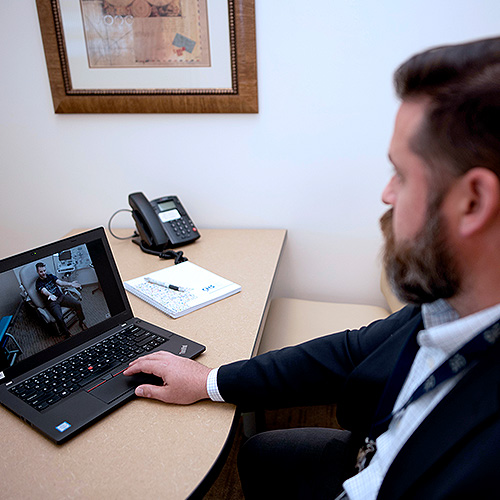Telehealth
TeleHEALTH Connects Patients and Clinicians in Real Time
Telehealth is an innovative, secure technology that enables real-time clinical interactions across the entire continuum of care. This leading-edge communication system allows practitioners in one location to communicate with patients in another location. Anytime, anywhere, clinicians can address a host of health issues immediately, eliminating the need for patient travel whenever possible.
 Amid COVID-19 Pandemic, Rehabilitation Continues
Amid COVID-19 Pandemic, Rehabilitation Continues
During the COVID-19 pandemic, CNS rehabilitation is in complete operation, utilizing telehealth to provide all therapies to patients in their home or at secure CNS residences and apartments. CNS therapists will conduct rehabilitation from the clinics and can add in specialists and physicians as needed. CNS staff can also consult simultaneously with family members, caregivers, and insurers.
CNS has deployed InTouch Health telehealth devices, which utilize components familiar to most patients: audio, video, tablets, and cameras. All six CNS clinical facilities in California and Texas have the InTouch TV Pro and an iOS Viewpoint tablet, a high-performance virtual care suite that enables detailed examinations and reading of patient monitoring devices, effectively placing the provider in the room with the patient.
InTouch monitors and interface are intuitive and user friendly and are similar to video call technology such as Skype. The camera can pan in and out, taking in a wide or narrow field of view to help identify specific issues. With this equipment, any HDMI-enabled TV or monitor can become a telehealth solution.
Secure, Private, and HIPAA Compliant
This robust suite utilizes a secure Zoom and RingCentral platform which supports real-time interaction as well as interactive document sharing. Zoom and RingCentral meet HIPAA and PIPEDA/PHIPA compliance standards with complete end-to-end 256-bit AES encryption.
The system can be used in a variety of circumstances, which include:
- Enabling remote access to CNS physicians and clinicians
- Connecting patients to outside specialists who can advise on select medical and behavioral challenges
- Collaborating with other medical specialists
- Gathering input from these specialists on a host of medical issues when the physical presence of, and examination by, a provider isn’t necessary
- Consultation with nursing staff, counselors, physical and cognitive therapists, and behavioral analysts in real time when patients need help
- Providing night and weekend input from a remote clinical source
- Flexibility for co-located clinicians who can access the system using a cell phone, tablet, iOS or pc device, and a camera
Clinical use of telehealth can also reduce the need for urgent care and emergency room visits, as certain medical evaluations and physician input can be accomplished via video interaction and sharing patient data.

